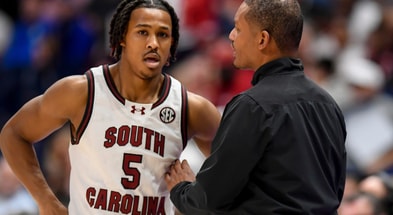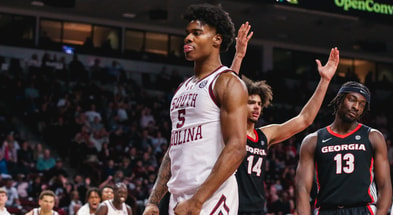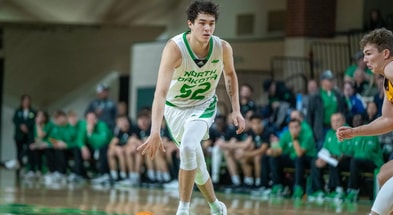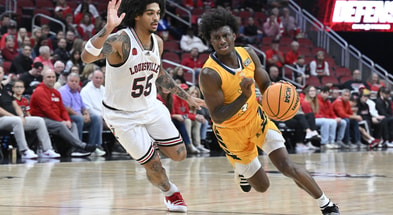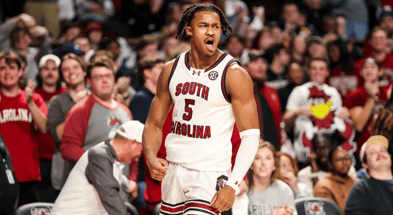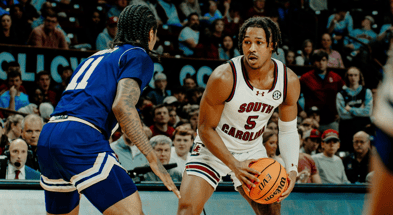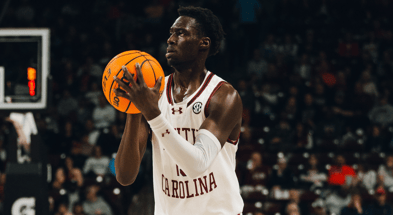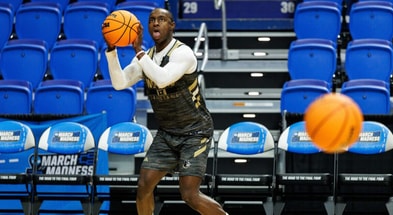1927 Men's Basketball: The Year of New and Wondrous Things

Alan Piercy is the author of A Gamecock Odyssey: University of South Carolina Sports in the Independent Era (1971-1991). The following was originally published on Alan’s South By Southeast newsletter.
The 1927 Gamecocks debuted a new home and a first-ever conference championship
For Gamecock fans old enough to remember, mention of the Carolina Field House conjures up faded memories of the antiquated venue it had become by 1968. The field house had served the university for over forty years by then, providing a home court for basketball, coaches’ offices, meeting rooms, and a gathering space for concerts and other university events. By 1968 the rapidly expanding campus surrounding it had long outgrown the old gym.
The growth was fueled by a booming post-war economy, the G.I. Bill, which made college widely accessible for the first time, and the matriculation of the Baby Boomer generation that followed.
Undergraduate enrollment at the University of South Carolina grew from 1,300 to over 10,000 during those years. That the field house had outlived its usefulness became even more glaring after Frank McGuire’s arrival in 1964. In short order, McGuire retooled the Gamecock basketball program into one poised to compete for Atlantic Coast Conference championships, and demand for tickets far outpaced the old venue’s scant 3,200 seats.
By the spring of 1968, cranes and construction crews worked feverishly as the hulking mass of Carolina Coliseum rose a few blocks west at the corner of Blossom and Assembly Streets. Shortly after the 1967-68 season, two mysterious fires definitively answered any lingering questions about the future of the field house as the Coliseum era dawned. Most outside of the immediate campus hardly noticed. Attention had turned to bigger, more modern things. The fires marked an unceremonious ending for a building that had served the campus nobly for decades.
But 1968 was not the first time basketball fever gripped the Capital City, nor was it the first time the Gamecocks inaugurated a shining new basketball venue while competing for conference championships to the delight of capacity crowds.
Gamecocks find a conference home and success in the Southern Conference
In 1921, fourteen schools split from the Southern Intercollegiate Athletic Association (SIAA), a loose conglomeration of 40 schools across the Southeast, to form the Southern Conference. Charter schools included Alabama, Auburn, Clemson, Georgia, Georgia Tech, Kentucky, Maryland, Mississippi State, North Carolina, N.C. State, Tennessee, Virginia, Virginia Tech and Washington & Lee.
South Carolina joined a year later, along with Florida, LSU, Mississippi, Tulane, and Vanderbilt. VMI and Sewanee joined over the next two years, and by 1929, the conference added Duke for an unwieldy 23 schools.
The Gamecocks’ first season in the SoCon, 1922-23, was a loser at 6-13 overall and 0-3 in an abbreviated conference slate under head coach Jack Crawford. By 1923-24 though, Carolina notched its first of four-straight winning seasons, improving to 11-9 with a 2-2 result in league play.
The following year, head coach Branch Bocock took the reigns. A rugged Virginian with a thick mop of blond hair, Bocock had been a star quarterback at Georgetown University before establishing a track record of multi-sport coaching success at prior stops in Georgia, Virginia Tech, North Carolina, and LSU. Bocock wore many hats at USC, coaching not just basketball but football and baseball and even serving a two-year stint as athletics director in 1925 and ‘26.
As head football coach those same two years, Bocock compiled a 13-7 record, and his .650 winning percentage still ranks among the best in program history. Perhaps most notable of Bocock’s gridiron successes was a 2-0 record over archrival Clemson in which the Gamecocks whipped the Tigers by a combined tally of 57-0.
Bocock was a winner on the basketball court, too, compiling a three-year record of 33-16 (.673) as cage coach. Nearly a century after he coached his final game at Carolina, he still holds a baker’s dozen of superlatives in the USC record book for winning percentage in various categories (home, away, conference, etc). He continued his bedevilment of Clemson on the court, winning five of six in that series. Most significantly, he led the Gamecocks to their first-ever conference championship in his third and final season.
1927 – The year of new and wondrous things
In the days before Columbia’s 3,100-seat Township Auditorium was completed in 1930, a bustling Capital City and university were in great need of a venue spacious enough to host large events as well as the full student body under one roof. A Nov. 21, 1926, article in The State lamented Columbia’s losing out on an opportunity to host that year’s state teacher’s convention because it had no auditorium large enough to accommodate the multitudes of attendees. In addition to providing a home for Gamecock basketball, the article noted, a new field house would “obviate this situation from occurring again.”
Bocock’s achievements as an administrator rivaled his coaching exploits as he oversaw a fiscal rehabilitation of the athletics department. He inherited a department some $13,000 in the red – a lot of money in those days – and by late 1926, engineered the erasure of that debt, even building a modest surplus.
He elevated facilities, overseeing the completion of a new athletics field, which became the home of Gamecock football between 1926 and the completion of Carolina Stadium in 1934. Melton Field, as it became known in honor of the late university president William Davis Melton, was located approximately where the Russell House Student Union sits now, along Green Street and adjacent to Davis Field, then the Gamecocks’ baseball diamond which sat in roughly the area of the Thomas Cooper Library reflecting pool today.
Bocock’s grandest project, though, was the Carolina Field House. Designed by architect Carroll Johnson and built by the Concrete Construction Company, both of Columbia, the field house rose at the corner of Devine and Sumter Streets during the fall of 1926, with a planned opening in time for Carolina’s first season matchup against Clemson on Jan. 7, 1927.
Built at a cost of $60,000 – just over a million in 2023 value – the field house was a game changer for the university and received wide praise as one of the finest facilities of its kind in the Southeast. Though it would take a little longer than planned, the Gamecocks did christen their new building in grand fashion with a two-game homestead versus the visiting Florida Gators in mid-February.
The Gamecocks sported a 9-3 record heading into that inaugural contest on Thursday evening, Feb. 17, 1927. The Florida series followed a four-game swing through Virginia in which the Gamecocks won two versus the Cavaliers in Charlottesville, then won at VMI before losing at William & Mary in Carolina’s first conference loss of 1927.
Earlier in the season, Carolina swept a two-game home stand versus Clemson in USC’s original home venue, the Carolina Gymnasium (now Longstreet Theatre). A sound trouncing of hapless Presbyterian was followed by a win over Tennessee, both at home. Two losses to Furman bookended another win over Clemson on the road, and a home victory over College of Charleston, the final game in Carolina Gymnasium, which preceded the Gamecocks’ “successful invasion of Virginia,” as newspaper reports described it.
Amid ads for Stetson hats, Lucky Strike cigarettes, and cure-all tonics, newspapers detailed the Florida game and scenes from Carolina’s new home, noting the assembled crowd was the “largest ever to attend a basketball game in Columbia, and possibly in South Carolina.”
The field house seemed cavernous to fans compared to the Gamecocks’ prior home across Sumter Street, which sat only a few hundred. From center court to the building’s roof was about the height of a three-story building, and the floor was sunken around three feet below the main level, putting fans literally on top of the action. From the floor rose “tier after tier of seats,” providing clear views from every angle. Though construction was not yet fully complete, the field house “presented a neat appearance” to the gathered spectators.
The Gamecocks clawed back from deficits in the first and second halves en route to a thrilling 39-33 victory, as guard Bill Rogers led all scorers with eleven points in a performance The State described as “scintillating.”
Carolina topped the Gators again on Friday night in an easier 37-28 win, pushing their conference record to 9-1, good for first place heading into the Southern Conference tournament in Atlanta just under two weeks later. A 34-29 win over Davidson on Feb. 21 capped the regular season and an admirable 3-0 start in their new home.
By virtue of their first-place league finish, Carolina secured its first-ever Southern Conference regular season title and the first title of any kind in the program’s nearly two decades of competition.
Top 10
- 1New
FSU Shooter
Police identify shooter
- 2Hot
Deion Sanders jab
CU coach blasts NCAA
- 3
Steve Angeli
ND QB enters portal
- 4
Lee Corso
Announces retirement
- 5Trending
Chad Baker-Mazara
Auburn star entering portal
Get the On3 Top 10 to your inbox every morning
By clicking "Subscribe to Newsletter", I agree to On3's Privacy Notice, Terms, and use of my personal information described therein.
The Gamecocks represented themselves well in the SoCon tournament at Atlanta’s Municipal Auditorium, defeating N.C. State and hometown favorite Georgia Tech and coming one win shy of the championship game, losing to eventual tournament champ Vanderbilt 31-25 in the semifinal round.
Bocock era ends, but 1927 rolls on
James Dickey described the pull of returning home in his 1981 essay, The Starry Place Between the Antlers,
“I was feeling the magnetic pull that draws from pine roots and kudzu vines for those born among them, and was being pulled South, deeper and deeper, not only by the sun-moon opposition over Lake Katherine but by a root-system something like vines, the whole of an underground as well.”
Perhaps feeling a similar pull, Bocock returned to his native Virginia following the 1927 baseball season. He coached football at William & Mary University in the Virginia Tidewater during two stints over the course of a decade between 1928 and 1938.
South Carolina would go on to additional success in the Southern Conference under a series of coaches, winning three regular season titles and one tournament championship between 1933 and 1945. A few years later, the Gamecocks joined Clemson, North Carolina, N.C. State, Wake Forest, Duke, Maryland, and Virginia in leaving the Southern to form the Atlantic Coast Conference in 1953.
1927, meanwhile, proved to be a font of new and wondrous things beyond the University of South Carolina.
On May 21 of that year, Charles Lindbergh piloted his single-engine Ryan monoplane, the Spirit of St. Louis, from Long Island, New York, to Paris, becoming the first man to cross the Atlantic by plane nonstop. Bill Bryson notes of Lindbergh’s flight in his book, One Summer – America, 1927, that when he landed at Le Bourget airport in Paris, he instantaneously became the most famous person in the world. The flight induced a rapturous following, on par with Apollo 11’s moon landing of 1969.
Just months later, Columbia’s own Paul Redfern attempted to top Lindbergh’s feat. To call Redfern an aviation enthusiast would be to dabble in reckless understatement. And it must be said, he was a bit of an eccentric. As a teenager, he was known to wear a goggled aviator’s helmet while walking the halls of Columbia High School. He built and flew his own kit airplane by the time he was sixteen.
In August 1927, at the age of 27 – the same as Lindbergh – Redfern set off on an audacious flight from Brunswick, Georgia, to Rio de Janeiro, Brazil, attempting to become the first to cross the Caribbean Sea by plane. If successful, he would have eclipsed Lindburgh’s newly minted flight record by over a thousand miles. His attempt, foolhardy though it may have been, embodied the patently swashbuckling bravado of the era.
On Aug. 27, Redfern departed Brunswick in his Stinson Detroiter with a few meager survival supplies, twenty sandwiches, two quarts of coffee, and two gallons of water.
In a time with virtually no navigational instruments, Redfern flew by the seat of his pants, navigating visually and hoping for good weather. Flying low over a Norwegian freighter, the Christian Krohg, a few hundred miles off the coast of South America, Redfern dropped a metal cylinder containing a message. The container promptly bounced off the deck of the ship and into the sea. Thankfully the note was gamely retrieved by one of the ship’s seamen – it read: “Point ship to nearest land, wave flag once for each 100 miles. Thanks, Redfern.”
Obligingly, the ship’s captain pointed him in the right direction, and a thankful Redfern departed toward South America, saluting the transfixed Norwegians, Bryson notes, “…with a snappy wave.”
He was later spotted by a fisherman off the coast of Venezuela, so we know he made it that far, indeed becoming the first person to fly across the Caribbean Sea. It is believed he went down somewhere in the jungles of Dutch Guiana (now Suriname). For years, reports came back from missionaries and other visitors to the interior of Dutch Guiana about a white man living among the Indians. It was said that he had taken a wife and was living peaceably, even being treated as a divinity because he had descended from the heavens. More than a dozen search parties were organized, and two men even died during the many quests, but there were no confirmed sightings. Alas, Redfern faded into obscurity.
1927 delivered a bevy of other notable moments as well. Babe Ruth hit 60 home runs that summer, setting the gold standard for slugging until Roger Maris topped the mark by one home run in 1961. The first true “talking” motion picture, The Jazz Singer, debuted that year, changing the film industry forever. Alvin “Shipwreck” Kelly sat atop a Newark, New Jersey, flagpole for twelve days in the quest to set a new world record for, well, flagpole sitting. Al Capone unleashed a murderous rampage as he consolidated power in the age of Prohibition.
The boundless energy and optimism of the 1927 manifested itself in ways sublime and bizarre, and sometimes sinister. Two years later, the world would be plunged into an economic depression and, soon after, a world war. 1927 was the party before the storm.
For the University of South Carolina, that party included a new field house, newfound relevancy in its conference home, and a first-ever championship.
So the next time you visit Colonial Life Arena, take a moment to glance up at that 1927 Southern Conference championship banner and give a nod to the rugged Virginian who delivered it and to that long-gone field house in which his Gamecocks played so well.


